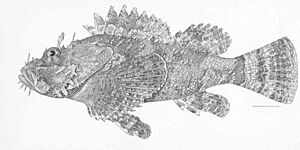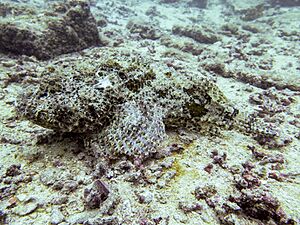Pacific spotted scorpionfish facts for kids
Quick facts for kids Pacific spotted scorpionfish |
|
|---|---|
 |
|
 |
|
| Conservation status | |
| Scientific classification | |
| Synonyms | |
|
The Pacific spotted scorpionfish (Scorpaena mystes), also known as the stone scorpionfish, is a type of marine fish. It belongs to the Scorpaenidae family, which are known as scorpionfishes. This fish lives in the eastern Pacific Ocean. It is the largest species in its group, called Scorpaena. Like other scorpionfish, it has venomous spines for protection.
About Its Name
Scientists give every living thing a special two-part name. This helps everyone know exactly which plant or animal they are talking about. The Pacific spotted scorpionfish was first officially described in 1895. Two American fish experts, David Starr Jordan and Edwin Chapin Starks, gave it its scientific name.
They found the first fish they studied near Mazatlán, Sinaloa in Mexico. The second part of its scientific name, mystes, is a Latin word. It means "initiated one" or "priest." The scientists didn't fully explain why they chose this name. However, they described the fish as being "olive brown, almost black." This might have made them think of the dark clothes worn by priests.
What It Looks Like
The Pacific spotted scorpionfish has a very bony head. This head is covered with many spines. It also has a deep dip behind its eyes and a smaller dip in front of them. Its head is as deep as it is wide, and it has a very large mouth.
- Spines and Fins:
- It has 12 spines and 9 or 10 soft rays in its dorsal fin (the fin on its back).
- Its anal fin (the fin on its belly, near the tail) has 3 spines and 5 or 6 soft rays.
- The pectoral fins (side fins) have 18 to 21 rays. The lower rays are thick and simple.
- Skin and Scales:
- Its head and body have many small skin flaps.
- It has fairly large scales that are smooth on its body.
- A complete lateral line runs along its side. This line is made of special scales that help the fish sense movement in the water.
- Size:
- This fish can grow up to about 45.7 centimeters (about 18 inches) long.
- However, it is more commonly found around 30.4 centimeters (about 12 inches) long. This makes it the biggest species in the Scorpaena group.
- Color:
- Its color can change a lot. It usually has a dull, mottled pattern of grey, brown, red, green, and black.
- It often has dark bars on its caudal fin (tail fin).
- The area where its pectoral fin meets its body usually has white spots. These spots are often in lines.
- The dorsal fin typically has one clear black spot, but it can have up to four spots.
- Young scorpionfish have a clear dark bar on their back, under the soft part of the dorsal fin.
Where It Lives
The Pacific spotted scorpionfish lives in the eastern Pacific Ocean. You can find it along the western coasts of the Americas. Its range stretches from southern California and the Gulf of California all the way south to Chile.
It also lives around several islands:
- The Galápagos Islands
- The Revillagigedo Islands
- Cocos Island
- Malpelo Island
This fish lives in different depths of water. You can find it from the shallow areas where the tide goes in and out, down to about 100 meters (328 feet) deep. It prefers reefs covered in seaweed or open areas with sand and rocky rubble on the seafloor.
Its Life and Habits
The Pacific spotted scorpionfish is an ambush predator. This means it hides and waits for its prey to come close. It uses its amazing camouflage to blend in with the seafloor. When a small fish swims by, the scorpionfish quickly opens its large mouth and swallows it.
Besides small fish, it also eats:
- Crustaceans (like crabs and shrimp)
- Cephalopods (like small octopuses or squid)
One of the most important things to know about this fish is that its spines are venomous. If you accidentally step on or touch a scorpionfish, its spines can inject venom. This is why it's important to be careful when exploring rocky areas where these fish might live.
Images for kids



